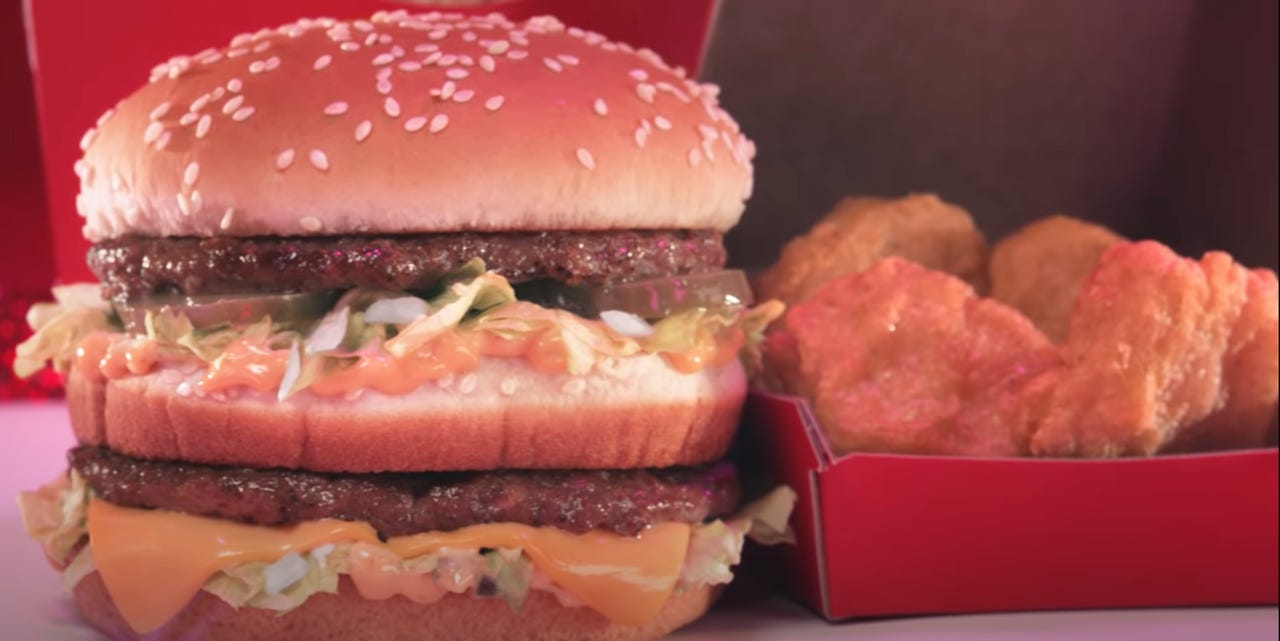
































Too much lettuce. Take some of it off. Now.
Screenshot by ZDNetI have learned to accept the inevitable.
Technology will slither its way into every part of human life, until we are less human and ever more bits and bytes.
I still don't want it to happen quickly, so that I can shuffle away without witnessing the true horror.
That's why, whenever I hear ideas such as this one, my mouth shrivels with the fear of distaste.
Please welcome Agot.ai. This claims to be "Pioneering QSR Technology with Computer Vision AI."
Some, when they hear more, might translate this as: We're going to spy on fast-food workers, so that they never, ever, ever make a mistake.
"Wouldn't it be more profitable," I hear you ask, "if this concept initially focused on fast-food chain senior executives?" It might help avoid a scandal or two.
But that's the lovely thing about AI, isn't it? It replaces those lower down the (fast) food chain first. And fastest.
Naturally, Agot.Ai's co-founder and CEO Evan DeSantola believes he has data on his side.
He toldCNBC: "We see that across the [quick-service restaurant] industry order accuracy is becoming an increasingly large problem as a result of the shift to drive-thru. What was once a smaller pain point, when the accuracy rates haven't gotten much better, is now a much larger pain point."
Perhaps. A new report from SeeLevel HX suggests that the average time customers spend at the drive-thru is now 25 seconds longer. Perish the depth of that pain.
As for order accuracy, it dropped from 87% to 85%. Hardly a plague, is it?
There may be reasons other than employees making errors for these numbers. Perhaps the fact that the likes of McDonald's and Chick-fil-A have brought in longer menus may have added to the confusion.
In any case, isn't it the case that if you complain about an order gone wrong, most fast-food establishments will be only too happy to fix things quickly and perhaps even throw in a bonus fry or two?
So is this alleged pain really the best object of technological commitment and investment? (Of course it is. Agot.ai has just raised$10 million.)
You, though, will already be wondering how Agot.ai's glorious idea works.
"Agot.ai technology employs off-the-shelf cameras as 'universal sensors' to collect data that is unattainable through other methods or technologies," says its website.
Don't you just adore the idea of a universal censor? I'm sorry, I mean universal sensor.
How uplifting to be spied on for whole shifts, while all you're trying to do is shift some burgers and make a few bucks. And being spied upon in a way no other method can attain.
But let's not dampen Agot.ai's excitement.
"Our Kitchen Awareness? platform captures meal orders from any channel, including in-store, online or drive-thru," says the company. Which it follows with: "Our Interventional Order Accuracy? technology then identifies items being prepared and issues real-time correction alerts to line workers, ensuring items are ingredient accurate and bagged correctly."
Such a proliferation of trademarks. I can only wonder how fast-food employees will get marked by real-time alerts. Or whether they'll be wired up for a tiny electric shock every time they forget a tomato.
Dangerously, it appears that all this computer vision -- aka employee surveillance -- is merely the beginning.
Greg Golkin, managing partner of the Kitchen Fund, an Agot investor, offered this toCNBC: "What was very clear to us about Agot is that it is not a point solution. It is a platform that is being built, and order accuracy is just the first application. Computer vision is not going to stop there."
I can think of something that might stop there: the ability of fast-food chains to hire too many humans.
Why would you take on a low-paying job if you know you're going to be spied on and corrected all day (and night) long? After all, some fast-food chains are currently shutting their dining rooms because they can't find employees. And it's not as if work in fast-food kitchens offers a salubrious environment.
The more dry of eye might observe that fast-food chains see a future where human employment should be minimized.
Instead, the likes of McDonald's and Chick-fil-A will become vast vending machines -- down the road from your house, just as the ice machine is down the corridor from your hotel room.
Agot.ai claims its customers are companies with at least 2,000 restaurants. Though I asked around, I could find no big brand that would admit to testing this technology, or something similar.
There may, though, be a certain pointlessness at its heart. McDonald's and others are already testing AI taking orders at the drive-thru. So how poetic it would be if Agot's AI spied on the order-taking AI, just to make sure it heard the customer's words correctly.
Meanwhile the humans, just desperate for a bite to eat, would stare in wonder as the robots duke it out.
 Tags quentes :
Negócio
Software Empresarial
Tags quentes :
Negócio
Software Empresarial